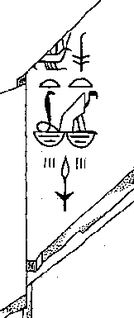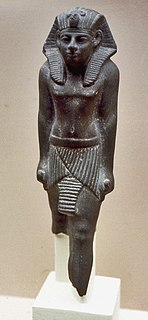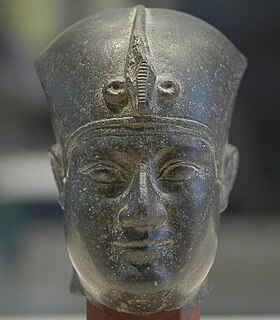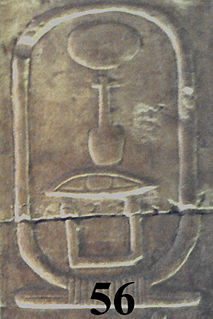Related Research Articles

Herihor was an Egyptian army officer and High Priest of Amun at Thebes during the reign of Pharaoh Ramesses XI.
The Eighth Dynasty of ancient Egypt is a poorly known and short-lived line of pharaohs reigning in rapid succession in the early 22nd century BC, likely with their seat of power in Memphis. The Eighth Dynasty held sway at a time referred to as the very end of the Old Kingdom or the beginning of the First Intermediate Period. The power of the pharaohs was waning while that of the provincial governors, known as nomarchs, was increasingly important, the Egyptian state having by then effectively turned into a feudal system. In spite of close relations between the Memphite kings and powerful nomarchs, notably in Coptos, the Eighth Dynasty was eventually overthrown by the nomarchs of Heracleopolis Magna, who founded the Ninth Dynasty. The Eighth Dynasty is sometimes combined with the preceding Seventh Dynasty, owing to the lack of archeological evidence for the latter which may be fictitious.

Hedjkheperre Setepenre Takelot II Si-Ese was a pharaoh of the Twenty-third Dynasty of Ancient Egypt in Middle and Upper Egypt. He has been identified as the High Priest of Amun Takelot F, son of the High Priest of Amun Nimlot C at Thebes and, thus, the son of Nimlot C and grandson of king Osorkon II according to the latest academic research. Based on two lunar dates belonging to Takelot II, this Upper Egyptian pharaoh is today believed to have ascended to the throne of a divided Egypt in either 845 BC or 834 BC. Most Egyptologists today, including Aidan Dodson, Gerard Broekman, Jürgen von Beckerath, M.A. Leahy and Karl Jansen-Winkeln, also accept David Aston's hypothesis that Shoshenq III was Osorkon II's actual successor at Tanis, rather than Takelot II. As Aidan Dodson and Dyan Hilton write in their comprehensive book on the royal families of Ancient Egypt:
Takelot II is likely to have been identical with the High Priest Takelot F, who is stated in [the] Karnak inscriptions to have been a son of Nimlot C, and whose likely period of office falls neatly just before Takelot II's appearance.

Sekhemkheperre Osorkon I was an ancient Egyptian pharaoh of the 22nd Dynasty.

Nebra or Raneb is the Horus name of the second early Egyptian king of the 2nd dynasty. The exact length of his reign is unknown since the Turin canon is damaged and the year accounts are lost. The ancient Greek historian Manetho suggests that Nebra's reign lasted 39 years, but Egyptologists question Manetho's view as a misinterpretation or exaggeration of information that was available to him. They credit Nebra with either a 10- or 14-year rule.

Weneg, also known as Weneg-Nebty, is the throne name of an early Egyptian king, who ruled during the second dynasty. Although his chronological position is clear to Egyptologists, it is unclear for how long King Weneg ruled. It is also unclear as to which of the archaeologically identified Horus-kings corresponds to Weneg.

Merankhre Mentuhotep VI was a Theban king of the Sixteenth Dynasty of Egypt based in Upper Egypt during the Second Intermediate Period. He was perhaps the 14th king of the dynasty.
The royal titulary or royal protocol is the standard naming convention taken by the pharaohs of ancient Egypt. It symbolises worldly power and holy might and also acts as a sort of mission statement for the reign of a monarch.

Hedjkheperre Setepenre Smendes was the founder of the Twenty-first dynasty of Egypt and succeeded to the throne after burying Ramesses XI in Lower Egypt – territory which he controlled. His Egyptian nomen or birth name was actually Nesbanebdjed meaning "He of the Ram, Lord of Mendes", but it was translated into Greek as Smendes by later classical writers such as Josephus and Sextus Africanus. According to the Story of Wenamun from c. 1000 BC, Smendes was a governor of Lower Egypt during the Renaissance era under the reign of Ramesses XI, however, Egyptologists have questioned the historical accuracy of that story.

Kheperkare Nakhtnebef, better known by his hellenized name Nectanebo I, was an ancient Egyptian pharaoh, founder of the last native dynasty of Egypt, the XXXth.

Usermaatre Setepenamun Osorkon III Si-Ese was Pharaoh of Egypt in the 8th Century BC. He is the same person as the Crown Prince and High Priest of Amun Osorkon B, son of Takelot II by his Great Royal Wife Karomama II. Prince Osorkon B is best attested by his Chronicle—which consists of a series of texts documenting his activities at Thebes—on the Bubastite Portal at Karnak. He later reigned as king Osorkon III in Upper Egypt for twenty-eight years after defeating the rival forces of Pedubast I/Shoshenq VI who had apparently resisted the authority of his father here. Osorkon ruled the last five years of his reign in coregency with his son, Takelot III, according to Karnak Nile Level Text No. 13. Osorkon III's formal titulary was long and elaborate: Usermaatre Setepenamun, Osorkon Si-Ese Meryamun, Netjer-Heqa-waset.

Rudamun was the final pharaoh of the Twenty-third dynasty of Ancient Egypt. His titulary simply reads as Usermaatre Setepenamun, Rudamun Meryamun, and excludes the Si-Ese or Netjer-Heqawaset epithets employed by his father and brother.

Aakheperre Shoshenq V was an ancient Egyptian pharaoh of the late 22nd Dynasty.

Neferkara I is the cartouche name of a king (pharaoh) who is said to have ruled during the 2nd dynasty of Ancient Egypt. The exact length of his reign is unknown since the Turin canon lacks the years of rulership and the ancient Greek historian Manetho suggests that Neferkara's reign lasted 25 years. Egyptologists evaluate his statement as misinterpretation or exaggeration.

Menkare was an ancient Egyptian pharaoh, the first or second ruler of the Eighth Dynasty. Menkare probably reigned a short time at the transition between the Old Kingdom period and the First Intermediate Period, in the early 22nd century BC. The rapid succession of brief reigns at the time suggests times of hardship, possibly related to a widespread aridification of the Middle East, known as the 4.2 kiloyear event. As a pharaoh of the Eighth Dynasty, according to Manetho, Menkare's seat of power would have been Memphis.

Neferirkare was an ancient Egyptian pharaoh of the Eighth Dynasty during the early First Intermediate Period. According to the egyptologists Kim Ryholt, Jürgen von Beckerath and Darrell Baker he was the 17th and final king of the Eighth Dynasty. Many scholars consider Neferirkare to have been the last pharaoh of the Old Kingdom, which came to an end with the 8th Dynasty.
The Seventh Dynasty of Egypt would mark the beginning of the First Intermediate Period in the early 22nd century BC but its actual existence is debated. The only historical account on the Seventh Dynasty was in Manetho's Aegyptiaca, a history of Egypt written in the 3rd century BC, where the Seventh Dynasty appears essentially as a metaphor for chaos. Since next to nothing is known of this dynasty beyond Manetho's account, Egyptologists such as Jürgen von Beckerath and Toby Wilkinson have usually considered it to be fictitious. In a 2015 re-appraisal of the fall of the Old Kingdom, the Egyptologist Hracht Papazian has proposed that the Seventh Dynasty was real and that it consisted of kings usually attributed to the Eighth Dynasty.
Nefertkau I was a 4th dynasty princess of ancient Egypt. She was the eldest daughter of King Sneferu and hence a half-sister to King Khufu. She was the mother of Nefermaat II and the grandmother of Sneferukhaf.
Hudjefa is the pseudonym for a 2nd dynasty pharaoh as reported on the Turin canon, a list of kings written during the reign of Ramses II. Hudjefa is now understood to mean that the name of the king was already missing from the document from which the Turin canon was copied. The length of the reign associated to Hudjefa on the canon is 11 years. Because of the position of Hudjefa on the Turin list, he is sometimes identified with a king Sesochris reported in the Aegyptiaca, a history of Egypt written by the Egyptian priest Manetho in the 3rd century BC. Manetho credits this pharaoh with 48 years of reign. Egyptologists have attempted to relate Hudjefa with archaeologically attested kings of the period, in particular Seth Peribsen.

Horus Sa was a possible early Egyptian pharaoh who may have reigned during the 2nd or 3rd dynasty of Egypt. His existence is disputed, as is the meaning of the artifacts that have been interpreted as confirming his existence.
References
- Legrain, Georges Albert (1896). "Les crues du Nil depuis Sheshonq Ier jusqu'à Psametik". Zeitschrift für ägyptische Sprache und Altertumskunde. 34: 119–121.
- Legrain, Georges Albert (1896). "Textes gravés sur le quai de Karnak". Zeitschrift für ägyptische Sprache und Altertumskunde. 34: 111–118.
- von Beckerath, Jürgen (1966). "The Nile Record Level Records at Karnak and Their Importance for the History of the Libyan Period (Dynasties XXII and XXIII)". Journal of the American Research Center in Egypt. 5: 43–55. doi:10.2307/40000171.
- Broekman, Gerardus P. F. (2002). "The Nile Level Records of the Twenty-second and Twenty-third Dynasties in Karnak: A Reconsideration of Their Chronological Order". Journal of Egyptian Archaeology . 88: 163–178. doi:10.2307/3822342. JSTOR 3822342.